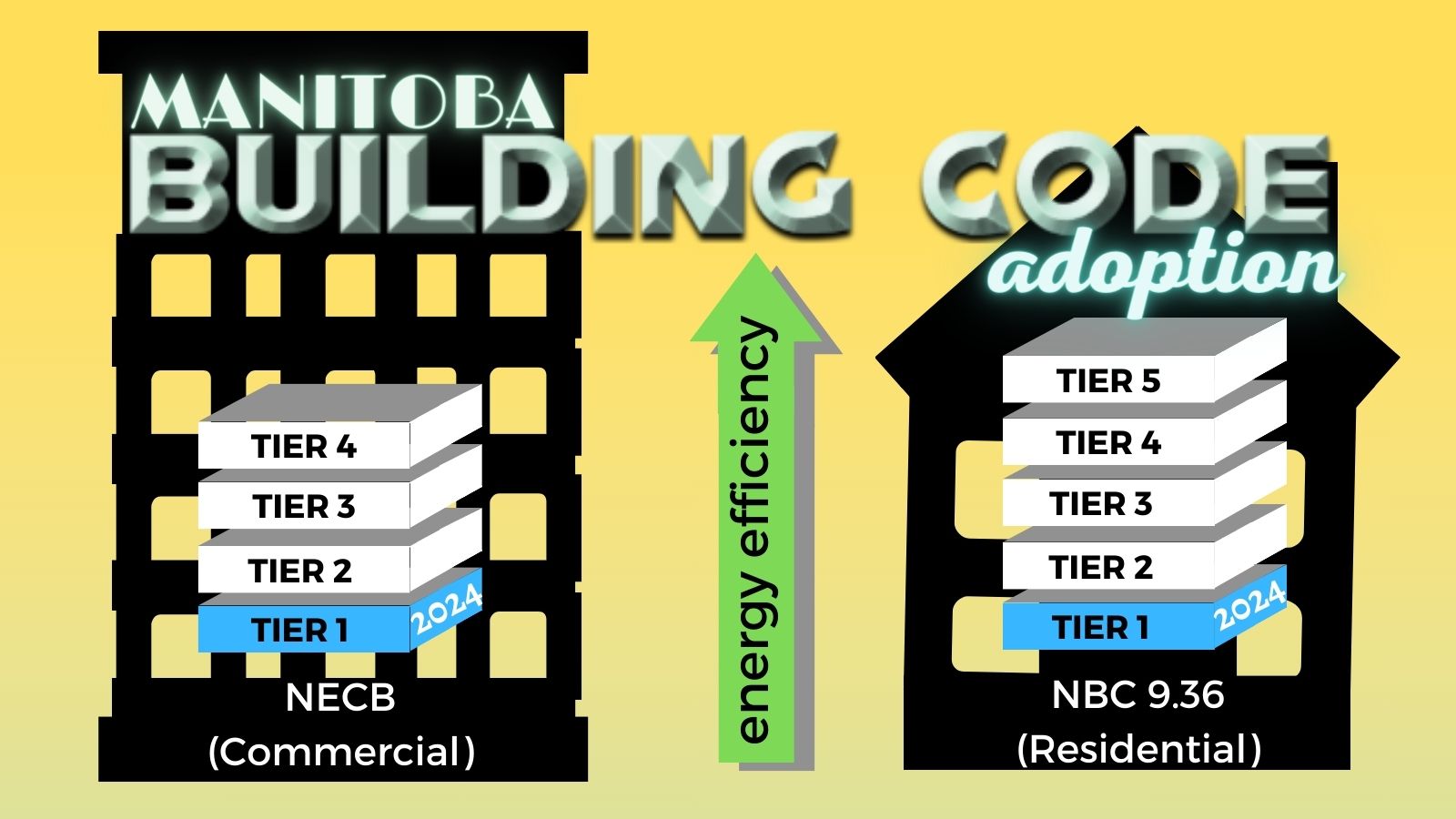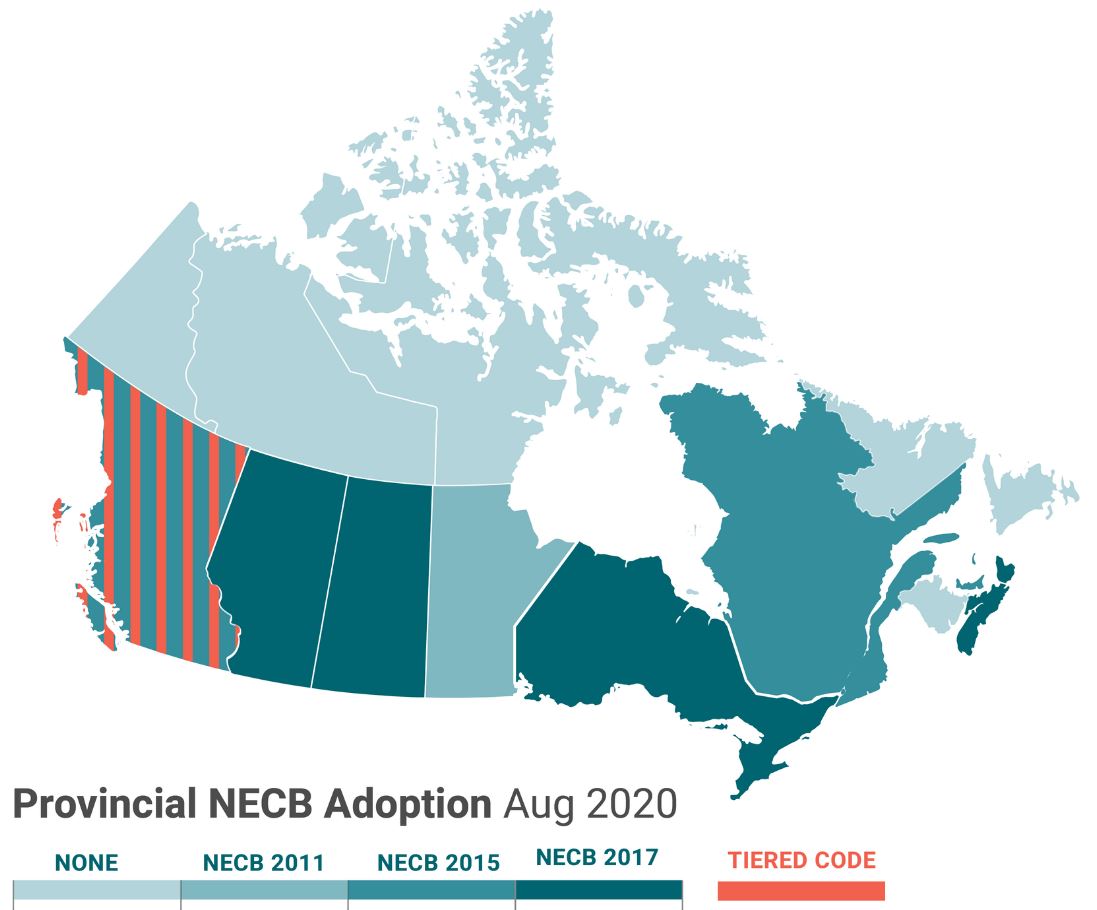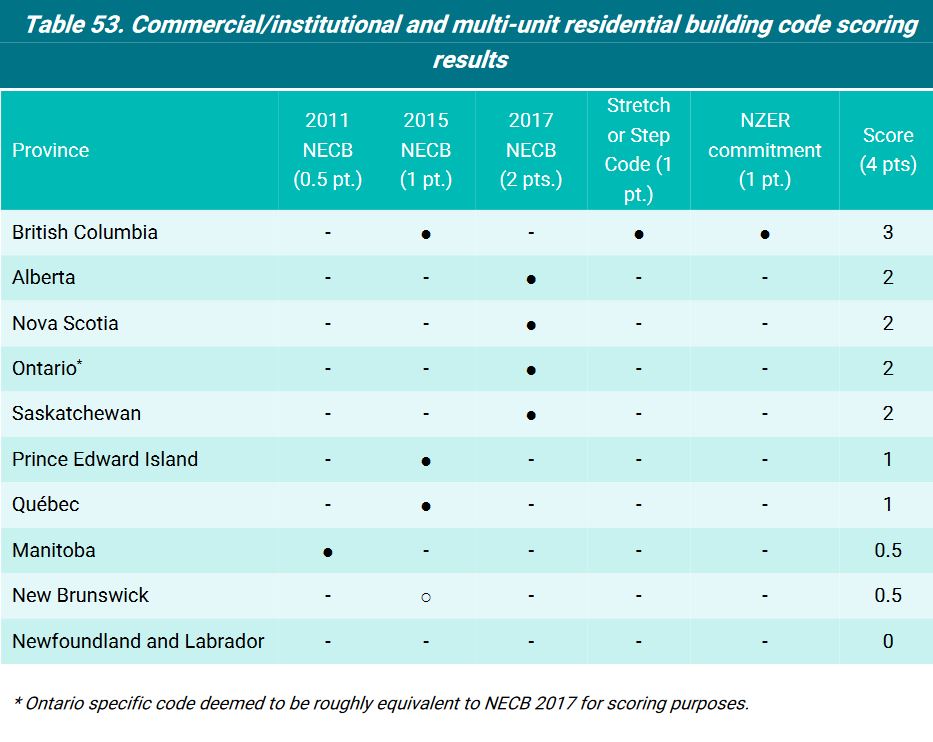
Building Codes are developed by the Federal government via the Canadian Commission on Building and Fire Codes and published by the National Research Council of Canada.
Provinces then adopt, usually with some amendments (though Manitoba passed a bill to Harmonize with what was released but that Bill was never fully implemented).
Municipalities implement codes through permits and inspections.
On January 1st 2024 the 2020 editions of the national model building, plumbing, energy and fire codes published by the National Research Council (NRC) will come into effect and be enforced. For energy efficiency, it is Tier 1 across the board for both commercial and residential.
Permitting and inspections authorities responsible for adopting and enforcing the Manitoba Building Code, Manitoba Plumbing Code and Manitoba Energy Code for Buildings will be required to approve building and plumbing permits based on the 2020 national model codes starting January 1, 2024. Inspections based on permits approved before January 1, 2024 must ensure compliance with approved plans based on the previous codes.
Manitoba’s construction codes are adopted with Manitoba specific amendments by regulation and are available on the Manitoba Laws website:
The Manitoba Building Code regulation:
M.R. 78/2023, Manitoba Building Code (gov.mb.ca)
The Manitoba Plumbing Code regulation:
M.R. 80/2023, Manitoba Plumbing Code (gov.mb.ca)
The Manitoba Energy Code for Buildings regulation:
M.R. 79/2023, Manitoba Energy Code for Buildings (gov.mb.ca)
The Manitoba Fire Code regulation
M.R. 82/2023, Manitoba Fire Code (gov.mb.ca)
These codes are the first to have energy efficiency Tiers.
The 2020 editions of the codes allow provincial and territorial regulators to select energy efficiency tiers for housing and small buildings under the National Building Code, with five tiers to choose from, and large or complex buildings under the National Energy Code for Buildings, with four tiers to choose from. The highest tiers for either code means a building realizes at least a 60 per cent reduction in energy consumption over the baseline Tier 1 and is a step towards Canada developing net-zero emissions codes by 2050, when new buildings will be powered entirely from non-emitting sources.
Manitoba is initially adopting the baseline Tier 1, for the building and energy codes and is working with the federal government to develop a roadmap and to build capacity in Manitoba for higher tier adoption in the future. Tier 1 represents approximately a 20 per cent energy efficiency improvement over the previous Manitoba requirements for large and complex buildings. While Tier 1 for housing and small buildings under the 2020 National Building Code remains comparable to the previously adopted 2010 edition, Manitoba will continue to have additional requirements for heat-recovery ventilation in residential applications on top of the national requirements, while working towards adopting higher tiers.
Learn more about Tiered Building Codes – What They Are, Why They Matter, and What It Means for Existing Buildings in Canada from Manitoba’s own ioAirFlow
Manitoba Government Powerpoint Template about energy efficiency code adoption.
TRAINING
Here are some resources on the new codes to help you familiarize yourself with them.
- Recordings of old sessions from Engineers and Geoscientists on the Climate West site
- An Introduction to Climate Change Through Codes, Standards and Regulations and Presentation Slides
- NECB 2020 Free online training developed by NRC and CSA Group:
RESOURCES
Inspection and Technical Services, Manitoba provides a comprehensive collection of documents designed to support compliance with provincial safety standards and regulations. The materials are categorized into three main types:
Bulletins: These are official communications that offer updates, clarifications, and interpretations of codes, regulations, and procedures related to various technical safety areas. For example:
-
-
ITS 25-003 – Engineered Roof Trusses and Floor Joists: Provides guidance on the use and inspection of engineered roof components.
-
ITS 22-017 – Tiny Homes: Offers information on regulatory considerations for tiny homes.
-
Guides: These documents serve as instructional resources to assist stakeholders in understanding and applying specific codes and standards. Examples include:
-
ITS BC Guide 04 – Part 9, New Dwellings and Additions: Offers guidance on constructing new dwellings and additions under Part 9 of the building code.
-
ITS BC Guide 05 – Building Permit Guide: Highlights information required when applying for a building permit.
Forms: A variety of standardized forms necessary for applications, permits, inspections, and certifications. Examples:
-
-
ITS BC Form 25 – Building Permit Application: Used to apply for a building permit.
-
ITS CS Form 04 – Application for Power Engineer Licence: Required to obtain your licence to practice as a power engineer in Manitoba.
-
These resources are intended to facilitate compliance with Manitoba’s safety regulations across various sectors, including building construction, boiler and pressure vessels, elevating devices, gas and oil installations, and trade certifications. They are regularly updated to reflect current standards and practices.
Significant Technical Changes – 2020 National Model Codes
Nearly 400 technical changes approved by the Canadian Commission on Building and Fire Codes are introduced in the 2020 editions of Canada’s National Model Codes. The most significant technical changes NATIONAL ENERGY CODE OF CANADA FOR BUILDINGS (NECB) are summarized below.
Click here to see a summary of all the different codes areas that was put together by the Canadian Commission on Building and Fire Codes.
Application
The application of the NECB is extended to cover alterations, such as tenant improvements, to buildings originally constructed in accordance with the Code.
Building envelope
Whole-building airtightness testing is introduced as an option for complying with air leakage requirements. Maximum overall thermal transmittance values for opaque building assemblies and fenestration are reduced to improve the thermal performance of the building envelope.
Lighting
Lighting power densities are updated to reflect improvements in the efficacy of lighting products available in the North American market. Lighting power allowances are provided for use in additional exterior applications, including applications not listed in the Code.
HVAC and service water systems
The trade-off compliance paths for HVAC and service water systems, which were complex and not widely used, are removed. Performance requirements for HVAC and service water heating equipment are updated to align them with Canada’s Energy Efficiency Regulations and relevant standards, and to add new equipment types.
Tiered energy performance compliance
New Part 10 is introduced to establish a performance compliance path with 4 tiers, each successive tier being increasingly stringent in terms of building energy consumption.
Find out the background on SBM’s building code advocacy efforts for higher Tier adoption. Energy performance tiers are established to provide a framework for the road map to achieving higher levels of energy efficiency.
BACKGROUND ON CODES
In 1997, Canada createdthe Model National Energy Code for Buildings,its first national standard for building energy performance.Fourteenyears later, the federal government updated it and renamed it the National Energy Code for Buildings (NECB). The 2011 NECB achieved a 25% performance improvement over its predecessor. The 2015 NECB included changes such as new thermal requirements for semi–heated buildings, and maximum allowable lighting power densities harmonized with the ASHRAE 90.1– 2013 standard. This version had an average annual energy savings of 2.5% over the 2011 NECB.The National Research Council estimates that the 2017 version of the NECB achieves an average annual savings of 7.8% to 11.9% above the 2015 version. (source: Efficiency Canada)
CURRENT CODES
Housing and Small Buildings
The Manitoba Building Code is adopted as regulation 31/2011 under the Buildings and Mobile Homes Act. Section 9.36 applies of the Manitoba Code applies to houses and smaller buildings and follows the 2012 National Building Code’s provisions for energy efficiency. The energy efficiency provisions came into force on April 1, 2016.
Large Buildings
The Manitoba Energy Code for Buildings (MECB) was created through regulation 213/2013 under the Buildings and Mobile Homes Act. It applies to “larger buildings” (greater than 600 square meters of floor area). The MECB follows the 2011 National Energy Code of Canada. This code became effective on December 1, 2014.
Stretch or Step Codes
No stretch or step codes have been adopted in Manitoba.
Net-zero energy ready commitment
No formal commitment to adopt net-zero energy ready building codes.
Manitoba is the only province that did not adopt the 2015 codes and so are the only ones building using the 2011 codes.
- higher insulation values on building envelope (walls, ceilings, fenestration, doors, etc)
- higher HVAC equipment energy efficiencies
- higher domestic hot water system equipment energy efficiencies
More details include:
- Energy codes serve to provide a uniform standard which influences how buildings are designed and built, offering several pathways; meet prescriptive requirements, evaluate trade-offs, or computer modelling of energy performance to show compliance.
- Each new release of the NECB serves to promote energy efficiency by incrementally raising the minimum performance thresholds of elements such as the windows, insulation and efficiency of heating, cooling and ventilation equipment.
- Manitoba currently uses the Manitoba Energy Code for Buildings (MECB) which was introduced in 2013 and adopted the National Energy Code for Buildings (NECB) from 2011 with a few amendments. From an energy performance perspective, one of the principal amendments of MECB 2013 was to improve the minimum energy efficiency of windows by about 10%.
- In the subsequent years, the MECB has not been updated, while other provinces have adopted more recent versions of the NECB, for example Ontario and British Columbian introduced their own specialized building energy codes in 2017, while Saskatchewan and Alberta both adopted the NECB 2017 in 2019.
- Among the changes that NECB 2017 introduced was the requirement to include the impact of thermal bridging, where a building component such as framing members or balconies allows heat to easily bypass the insulation layer, and lowers the effective thermal resistance of the building envelope. Depending on the type of construction, this can be a significant change which will generally require more insulation and careful detailing to pass Code.
- Manitoba is now lagging behind in code adoption, and while further delays won’t be doing our building industry any favours, it is important to introduce a new code in a manner which is carefully planned and well supported. New buildings constructed today will need to fit into Canada’s strategy to achieve Net Zero by 2050 and deliver on its commitments to address the climate change crisis.
Report on Strengthening Canada’s Building Code Process from Efficiency Canada
Report on Tiered Energy Codes Best Practices for Code Compliance
Future Codes
In 2021 the Manitoba Government passed Bill 38 (The Building and Electrical Permitting Improvement Act) to harmonize with the National model building codes.
SBM submitted this letter of support for Bill 38 in January 2021
Some additional background:
1. The 24 month and 18 month period in the legislation is required to allow projects in the design phase to proceed to construction/permitting phase with certainty of not having to redo the design. Developers, consultants and contractors require this certainty for budgets, schedules, etc. It also allows time for the stakeholders to be educated on the additional requirements in the new code. In other words, you can’t just flip a switch and have the code come into effect without a lot of market disruption. Please note that NECB 2011 was proclaimed on December 20, 2013 and came into effect in Manitoba on December 31, 2014 and that SBM and others did lots of educational programming for that to happen so quickly!
2. Here is the Regulation that adopted the NECB 2011 and amendments. It is hard to tell how significant the amendments were but there is nothing in Bill 38 that prohibits Manitoba from doing amendments. The opinions are that the new code requirements and frequency of new codes are going to be so incrementally greater than previous, that amendments will not be an issue anyways – it will be fast and furious!
3. It has been mentioned that the Manitoba Building Codes committee is not active any longer and that Manitoba input into the code development will be diminished. The Canadian Commission on Building and Fire Codes policy position is to “analyze the impact of a uniform performance goal for all of Canada compared to regionally-specific goals and pay particular attention to constraints in Canada’s North.” As well, CCBFC works closely with the Provincial/Territorial Policy Advisory Committee on Codes (PTPACC) of which Manitoba is represented.
This page is a work in progress. If you have suggested additions or edits please send them using this form
On May 12th 2022, SBM hosted a lunch and learn on the topic
- What do Manitoban’s need to know about Canada’s first national tiered building codes?
- How do these codes differ from conventional codes?
- And,what can we do to lay the groundwork for successful adoption and compliance?



